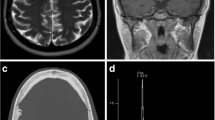Abstract
Our purpose was to verify the histological appearance of the dural tail accompanying meningiomas on MRI. We studied seven patients such a dural tale. We examined the point of attachment of the tumour and the adjacent dura mater histologically. In all patients, rich vascularity and dilated vessels were observed in the dura mater at the point of attachment of the tumour; tumour cells invaded the dura mater and vessels, packing the latter. In the adjacent dura mater, showing as a dural tail on MRI, there was tumour-cell invasion in only one patient. Vascular congestion around the vessels compacted by the tumour cells in the dura mater and dilated vessels were seen in all patients. We therefore suggest that the mechanism of the dural tail sign is as follows. First, tumour cells invade vessels and pack them at the point of tumour attachment. Then, vessel congestion is induced in the adjacent dura mater, as a result of which it enhances markedly, giving rise to the dural tail sign.
Similar content being viewed by others
Author information
Authors and Affiliations
Additional information
Received: 31 July 2000 Accepted: 29 September 2000
Rights and permissions
About this article
Cite this article
Kawahara, Y., Niiro, M., Yokoyama, S. et al. Dural congestion accompanying meningioma invasion into vessels: the dural tail sign. Neuroradiology 43, 462–465 (2001). https://doi.org/10.1007/s002340000524
Issue Date:
DOI: https://doi.org/10.1007/s002340000524




